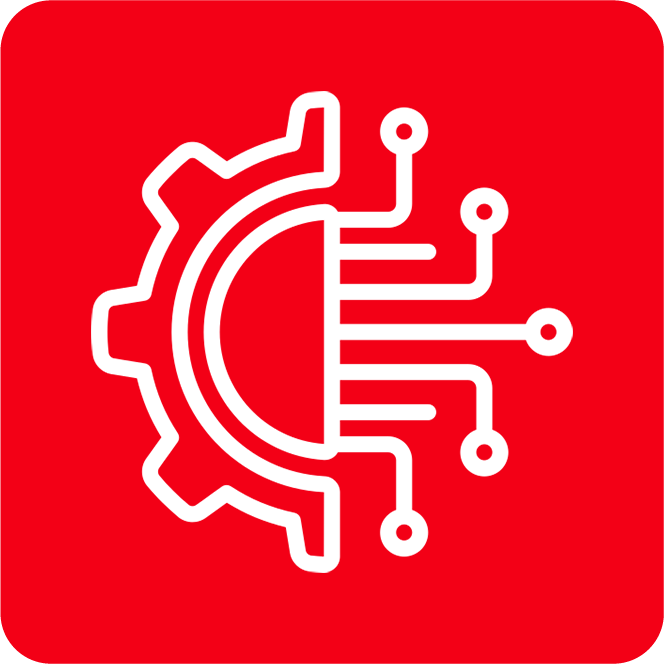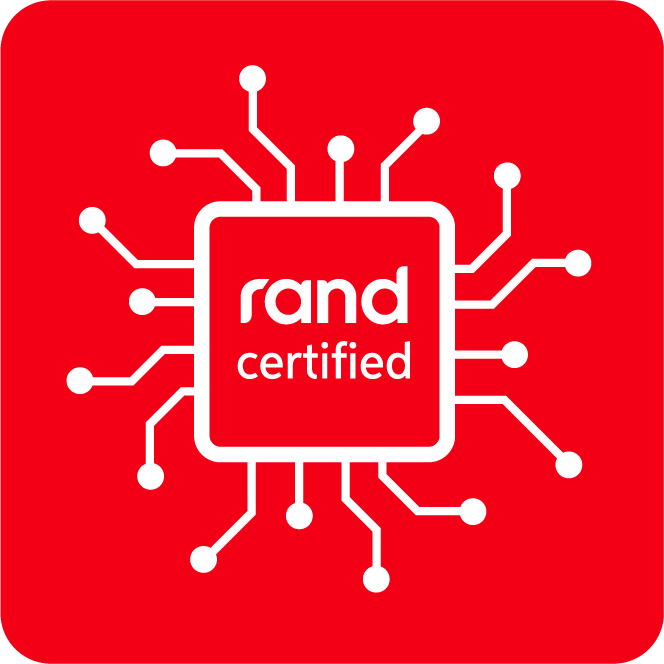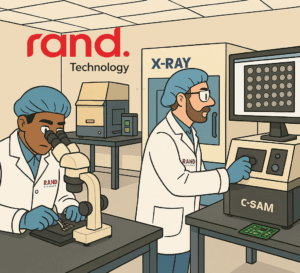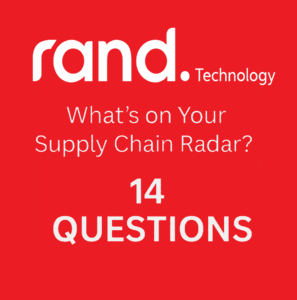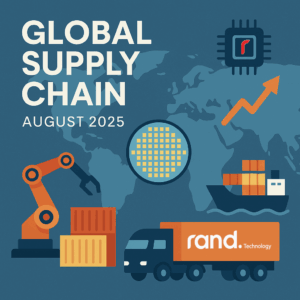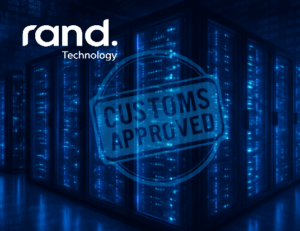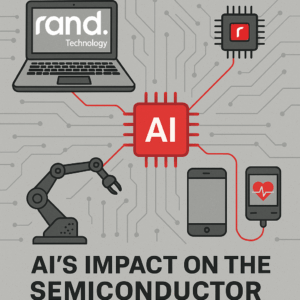There are moments in the tech world when everything feels like it’s about to change. Not in a distant, theoretical way—but in a “we’re living through it” kind of way. The rise of artificial intelligence is one of those moments. It’s not coming. It’s here. And nowhere is that more evident—or more disruptive—than in the semiconductor industry.
For decades, semiconductors have quietly powered the world: behind our screens, under the hood of our cars, inside our homes, humming away in the data centers that store our memories and transactions. But the arrival of AI has flipped the script. Suddenly, the semiconductor industry isn’t just a supporting actor—it’s the headline.
And this spotlight isn’t just about demand. It’s about transformation. Across design, production, supply chains, and strategic planning, AI is forcing companies—from foundries to OEMs—to rethink how they operate. At Rand Technology, we’re seeing these shifts play out every day. The ground is moving under everyone’s feet, and the pace is only accelerating.
Let’s talk about what’s really happening—and what it means for the future.
AI Isn’t a Trend. It’s a Reshaping Force.
AI isn’t a new technology—it’s a new era. And it’s demanding a new class of semiconductors: powerful, efficient, and deeply customized for tasks like machine learning, neural networking, and edge processing.
This shift is doing two big things.
First, it’s concentrating demand in ways we haven’t seen before. We’re not talking about broad, even growth across all markets. We’re talking about hyperscalers and infrastructure giants buying up advanced chips at an unprecedented rate, often years ahead of time.
Second, it’s changing the way suppliers allocate their resources. Companies that once spread capacity across a range of products are now narrowing their focus. They’re prioritizing AI modules, advanced memory (like HBM), and bleeding-edge nodes. That means older components—the ones that still power a significant portion of the world’s infrastructure—are receiving less attention.
And that’s where the pressure starts.
The Supply-Driven Shortage No One Wants to Talk About
Most people remember the 2021–2022 chip shortage. The world reopened after COVID, and demand surged. Everyone wanted everything: cars, laptops, servers, routers. Supply couldn’t keep up—but it was trying. Lead times stretched, prices soared, but parts were still flowing (eventually).
That was a demand-driven shortage.
Now, we’re on the cusp of something very different: a supply-driven shortage. Not because demand is exploding, but because suppliers are pulling back. They’re cautious. They’re cutting capacity. They’re shifting focus. And they’re doing it just as some sectors are beginning to recover.
At Rand, we’re already seeing the signs:
- Lead times are creeping out quietly, especially for mature-node silicon and legacy memory
- Passive components are stable but could be tightening, even as forecasts remain modest
- Suppliers choosing where to invest—favoring high-margin AI parts over lower-priced staples
This forecast isn’t panic-inducing, yet. But it’s a warning. The AI boom is creating a two-speed world: one for those in the fast lane of high-performance compute—and one for everyone else trying to catch up.
AI Is Stretching the Supply Chain in Every Direction
Let’s be clear: AI is good for the industry. It’s driving innovation. It’s pushing investment. It’s revitalizing conversations about domestic manufacturing, resilience, and digital infrastructure.
But it’s also causing bottlenecks.
Because AI hardware is so specialized, it puts pressure on specific parts of the ecosystem, including high-bandwidth memory, Advanced packaging, Copper interconnects, and Cutting-Edge photolithography tools. These aren’t generic materials—they’re niche, costly, and already in short supply.
Meanwhile, suppliers are increasingly deprioritizing the components that traditional sectors, such as automotive, industrial, and medical, still rely on. A data center may need 30 advanced modules. A car might need 3,000 simpler chips. But if capacity is finite, who gets priority?
You can probably guess the answer.
That’s why it’s not just about volume. It’s about allocation. And in today’s market, relationships and execution matter more than ever.
Forecasting Is Broken—and AI’s Not Helping
During the COVID years, forecasting became an art form. Some companies over-forecasted, leading to bloated inventory and painful corrections. Others under-forecasted, betting on just-in-time supply chains that quickly fell apart.
Now, we’re in a weird in-between. Many OEMs are still playing it safe—keeping forecasts conservative, holding back on reorders, trying not to overextend. But that conservatism comes with a risk: if demand recovers even modestly—and it is in sectors like networking and industrial—those suppliers may not be able to respond quickly enough.
Why? Because they’ve already shifted capacity elsewhere.
We’ve seen this before. And we know how it ends: with buyers scrambling, prices spiking, and lead times stretching into next year.
AI isn’t breaking forecasting. But it’s making it harder to rely on the old playbook.
Memory, Silicon, and Everything In Between
Let’s zoom in for a moment.
Memory: DDR4 is going end-of-life faster than many realize. Suppliers are cutting back. Customers are assuming it’ll be around. That mismatch? It’s a problem. And it’s happening right now.
Silicon: Foundries are at capacity, particularly at nodes used for AI applications. But even older nodes are tight, because suppliers are reallocating their wafer starts. If you’re not part of the AI gold rush, you might find yourself at the back of the line.
Passives and Interconnects: Often overlooked, these are now among the most constrained sectors. AI systems consume more power and require more complex connections, driving demand for components like tantalum capacitors and copper-based connectors. With very little new investment in these areas since the pandemic, it’s a recipe for disruption.
In short, the AI boom is rippling across every category, even those not directly tied to it.
Policy, Politics, and Production
It’s impossible to separate semiconductors from geopolitics anymore. Tariffs, subsidies, export bans—they’re all part of the story. AI has only amplified this. The chips that power AI models are now considered strategic assets. The U.S. is incentivizing domestic production. China is pouring billions into self-sufficiency. Europe is trying to catch up.
At Rand, we’ve had to help customers pivot midstream—moving builds from one region to another, navigating shifting tariff codes, and working with suppliers suddenly affected by export restrictions. These disruptions aren’t just background noise; they are driving a structural change in how—and where—companies build semiconductors. And if you’re not prepared for it, it can throw your entire supply chain into chaos.
What Can Companies Do?
If you’re in procurement, supply chain, or engineering, here’s what we think matters most right now:
- Be proactive. Don’t assume “normal” is coming back. It’s not. Build buffers. Place orders early. Think six to twelve months ahead.
- Know your risk areas. What’s at risk on your BOM? Are there legacy parts with fragile supply? Are you relying on a single fab or region for your manufacturing? Map it now—before you need to react.
- Leverage relationships. In a supply-driven environment, execution matters more than price. Get close to your suppliers. Understand their priorities. Partner, don’t just transact.
- Stay flexible. Things will shift—tariffs, demand, availability. Build flexibility into your sourcing plans. Consider alternatives. Stay agile.
- Invest in visibility. You can’t manage what you can’t see. Whether it’s through analytics, partners, or better internal alignment, clarity is everything.
Rand’s Role in All of This
At Rand, we’re not just watching these trends—we’re helping our partners navigate them. Whether it’s securing hard-to-find parts, managing multi-country builds, or simply acting as a trusted second set of eyes, we pride ourselves on being more than a distributor. We’re a solutions provider.
The AI era is full of opportunity. But it’s also full of risk. Companies that get caught flat-footed—assuming the supply chain will “just work”—are going to struggle. Those who prepare, stay curious, and take decisive action will come out ahead.
And we want to help you be in that second group.
AI is changing everything—but not always in obvious ways. While headlines focus on big valuations and more innovative tools, there’s a deeper story playing out: one of resource reallocation, emerging constraints, and new rules for survival.
For the semiconductor industry, this is a defining chapter. It’s not just about making more chips—it’s about making the right chips, in the right place, at the right time.
At Rand Technology, we’re committed to helping our partners unlock the flow of technology in this new era—strategically, globally, and with integrity.
Let’s not just keep up. Let’s lead.



